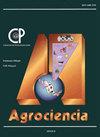玉米-玉米模型遗传系数的无损估计
IF 0.5
4区 农林科学
Q4 AGRICULTURE, MULTIDISCIPLINARY
引用次数: 0
摘要
农业技术转移决策支持系统(DSSAT)中的作物环境资源综合-玉米(CERES-Maize)机制模型是模拟不同环境下玉米生长和产量的有效工具。提供给CERES-Maize模型的定性和定量信息保证了仿真结果的可靠性。然而,它需要大量的信息,如土壤特征、日常气候、作物特征和管理,以及六个遗传系数。本研究评估了一种非破坏性的方法,用于估算六个所需参数(遗传系数):P1, P2, P5, G2, G3和PHINT,基于玉米生理,从生长度天数(GDD)基数10测量。在墨西哥莫雷洛斯州Tlaltizapan的国际玉米小麦改良中心(CIMMYT)试验站建立了一项试验,在灌溉保护性耕作系统中人工播种27种白玉米杂交种和14种黄玉米杂交种。利用CERES-Maize模型对玉米生长和产量进行模拟后,利用广义似然不确定性估计(GLUE)对遗传系数进行校准。对所有杂种的6个遗传系数进行校正后,P1、G2和G3的平均值在典型范围内,P2和P5的平均值大于典型范围,PHINT低于典型范围。然而,经校正后,模拟模型表现出良好的性能,白色和黄色杂交种的实测产量与模拟产量的平均R2分别为0.9809和0.9730。本研究中估计的系数可用于CERES-Maize模型,以模拟该国不同地区使用的杂交品种的玉米产量。本文章由计算机程序翻译,如有差异,请以英文原文为准。
ESTIMATION OF MAIZE GENETIC COEFFICIENTS FOR THE CERES-MAIZE MODEL USING NON-DESTRUCTIVE METHODS
The Crop Environment Resource Synthesis-Maize (CERES-Maize) mechanistic model, included in the Decision Support System for Agrotechnology Transfer (DSSAT), is a useful and powerful tool that simulates the growth and yield of maize in different environments. The qualitative and quantitative information provided to the CERES-Maize model guarantees reliability in the simulations obtained. However, it requires a lot of information such as soil characteristics, daily climate, crop characteristics and management, as well as six genetic coefficients. This research assessed a non-destructive methodology for estimating the six required parameters (genetic coefficients): P1, P2, P5, G2, G3 and PHINT, based on the maize physiology, measured from the Growing Degree Days (GDD) base 10. An experiment was established at the experimental station of the International Maize and Wheat Improvement Center (CIMMYT) in Tlaltizapan, Morelos, Mexico, where 27 white maize hybrids and 14 yellow maize hybrids were manually sown in an irrigation conservation tillage system. Once the simulations of maize growth and yield were obtained with CERES-Maize model, the genetic coefficients were calibrated using the Generalized Likelihood Uncertainty Estimation (GLUE). After calibration of the six genetic coefficients for all hybrids, an average values of P1, G2 and G3 were within the typical range, while P2 and P5 were greater than the typical range, and PHINT was below typical range. However, the simulation model showed good performance after calibration, according to the average R2 of 0.9809 and 0.9730 between measured and simulated yields for white and yellow hybrids respectively. The coefficients estimated in this study can be used in the CERES-Maize model to simulate maize yields in different regions of the country for the hybrids used here.
求助全文
通过发布文献求助,成功后即可免费获取论文全文。
去求助
来源期刊

Agrociencia
农林科学-农业综合
CiteScore
0.50
自引率
33.30%
发文量
51
审稿时长
18-36 weeks
期刊介绍:
AGROCIENCIA is a scientific journal created and sponsored by the Colegio de Postgraduados. Its main objective is the publication and diffusion of agricultural, animal and forestry sciences research results from mexican and foreign scientists. All contributions are peer reviewed. Starting in the year 2000, AGROCIENCIA became a bimonthly and fully bilingual journal (Spanish and English versions in the same issue). Since 2007 appears every month and a half (eight issues per year). In addition to the printed issues, the full content is available in electronic format.
 求助内容:
求助内容: 应助结果提醒方式:
应助结果提醒方式:


